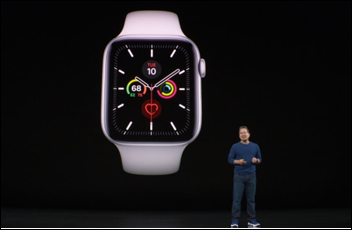The primary point of using the Cloud is using operating expenses vs limited capital ones and avoiding having to update…
News 9/11/19
Top News
Bayfront Health St. Petersburg (FL) pays $85,000 to settle Office for Civil Rights charges that it failed to provide a woman with the fetal heart monitor records of her unborn child within HIPAA’s 30-day window. This is HHS OCR’s first case brought under HHS’s Right of Access Initiative that was announced earlier this year.
The mom didn’t get the information until nine months later, and then only after she filed an OCR complaint.
The hospital is part of Bayfront Health, which is owned by for-profit Community Health Systems.
The hospital also agreed to a corrective action plan that includes revising PHI-related policies and procedures if necessary, validating its Designated Record Set Policy, training its employees who manage information requests, and providing HHS with a list of its business associates.
The settlement is important since it signals OCR’s belated interest in going after health systems that have been widely ignoring the requirement that they give patients copies of their records promptly and at a reasonable cost.
Reader Comments
From Banga Gong: “Re: physician burnout. What about other people who are burned out? You don’t read much about them.” Agreed. Many Americans are experiencing the cultural phenomenon of burnout that is caused by excessive workload, too much time wasted in conference rooms and on email, an always-on expectation of answering work messages around the clock, jobs that discourage creativity or individualism, a disconnect between accomplishment and rewards, general executive cluelessness and indifference, and employers whose social mission and human connection are coincidental at best. They make it worse by wasting endless time staring at their phones and anguishing second by second over political nonsense instead of cultivating in-person relationships, breathing fresh air, and stepping out of their consumptive role as never-rest shoppers. Therefore, I’ll take the harsh point of view that doctors who have decided to become employees are belatedly finding out that it’s not so great being an employee in the US these days, no matter how much you’re paid. Thousands of lower-earning people name email or Slack as the corporate villain for every doctor who blames the EHR for their unhappy work life. Forming a union isn’t likely to help, so the choices are to (a) find a more suitable physician job; (b) leave the profession and do something else; or (c) become self-employed. Complaining while remaining isn’t a good look, but I can understand why doctors are especially unhappy because their entire post-high school lives were structured around being gunners who earned rewards by beating others.
From Mensch: “Re: layoffs. How would readers know if a layoff seems to unfairly target more expensive workers?” They can easily go down a self-made list of newly vacant cubicles and tally the dearly departed by age group, position level, known health problems or frequent absences, etc. I’ve been involved in health system layoffs, and while HR ran our proposed IT layoff list through a discrimination testing program to make sure we wouldn’t get sued, the end result was that we just took the first run of the program to see if we had the prescribed mix of ages and males-female, then chose more younger people or females or whatever we needed to get the spreadsheet’s green light. In other words, some people were cut loose purely to balance our desire to get rid of some of their peers. I’m saying “we,” but the decision was made above my level by an executive who was new and therefore naive enough to think that his gung-ho team play would benefit him as a man of decisive action.


From Alan: “Re: Netflix documentary ‘Diagnosis.’ See attached screen grabs. S1-E6 shows a Johns Hopkins neurologist writing a paper note in front of his Epic screen. Seems like he could have more room to write if it weren’t for that annoying keyboard.” The patient is probably happier to have the doctor at least looking him most of the time since the room arrangement doesn’t readily support showing the patient the screen while entering information. Large monitors and even projectors are super cheap and small these days, so it would be nice to have both participants looking at the same screen image as a teaching point. My tax guy has a large monitor behind his desk that we look at together when he is explaining stuff and it works great, especially since his wireless keyboard keeps him untethered.
HIStalk Announcements and Requests
A relative of mine is a family doctor who has worked for years (not all that happily) for a multi-specialty clinic whose foreign-trained physician-owner pushes the medical staff hard to increase patient volume and keeps elevating the bonus targets. The relative says working conditions suddenly got worse recently as the clinic “got a new investor” (which I take to mean that it was sold to a big investment group), a new practice manager was installed who chews out the doctors over administrivia, and the whip is being cracked harder to make new number targets. Sometimes you forget that even modest private medical offices can be the storefront for big business.
I was also talking to a doctor friend who gets insurance from his academic medical center employer. He found when his kids went to college that his employer’s family plan offers basically no coverage outside its immediate area. I wonder how many of us know what would happen financially if we’re taken to an ED unexpectedly while on vacation several states away from home?
Webinars
September 19 (Thursday) 2:00 ET. “ICD-10-CM 2020 Code Updates.” Sponsor: Intelligent Medical Objects. Presenters: June Bronnert, MSHI, RHIA, director of terminology mapping, IMO; Theresa Rihanek, MHA, RHIA, classification and intervention mapping lead, IMO; and Julie Glasgow, MD, senior clinical terminologist, IMO. The 2020 regulatory release is right around the corner. Join IMO’s top coding professionals and thought leaders as they discuss new, revised, and deleted codes; highlight revisions to ICD-10-CM index and tabular; discuss changes within Official Coding Guidelines; share potential impacts of the code set update; and review ICD-10-CM modifier changes.
September 26 (Thursday) 2 ET. “Patient Education Data: A Key Ingredient for Improving Quality and Patient Experience.” Sponsor: Healthwise. Presenters: Victoria L. Maisonneuve, MSN, RN, director of the Nursing Center for Excellence and Magnet program, Parkview Health; Marta Sylvia, MPH, senior manager of quality improvement and outcomes research, Healthwise. Healthcare data is everywhere! It’s scattered across various systems and in countless formats, making it difficult to collect and glean actionable information. Knowing where to start depends on what your organization wants to accomplish. Vicki Maisonneuve will share how her team analyzes data around the use of patient education. By combining different data sets, she can easily identify trends, gaps, and opportunities to improve quality and patient experience across Parkview Health.
Previous webinars are on our YouTube channel. Contact Lorre to present your own.
Acquisitions, Funding, Business, and Stock
A ProPublica report finds that private health insurance companies, unlike Medicare and Medicaid, don’t pursue widespread and sometimes obvious examples of healthcare fraud because they can simply pass its cost on to consumers in the form of higher premiums.
Sales
- Mayo Clinic signs a 10-year partnership with Google in which Google Cloud will provide Mayo with data hosting, cloud computing, analytics, and machine learning and AI.
- Cerner signs three new CommunityWorks clients: Eastland Memorial Hospital (TX), Pawhuska Hospital (OK), and Schoolcraft Memorial Hospital (MI).
People

BioBright, whose technology extracts medical device information for research, hires industry long-timer Edward Chung, MD (Covenant Health) as chief medical officer.

Michael Keyes, MBA, PT (3M Health Care) joins Collective Medical as VP of health plan business development.

Patient engagement technology vendor Conversa hires Cameron Ough, MSc (Cigna) as CTO.

Healthcare talent management software vendor HealthcareSource names Michael Grossi (Ipswitch) as CEO. He is also a former Air Force captain in Intelligence Command.

Cerner EVP / Chief of Innovation Jeff Townsend will retire this year after 30 years with the company.
Announcements and Implementations
A Spok survey of hospital employees on mobile strategies finds that poor wi-fi and cellular coverage remain the biggest problems, although improving. More than half of non-clinical staff still use pagers, which respondents say provide better coverage than any other communications device.
Carolina EHealth Alliance reports expanded adoption among state EDs after it switches vendors to Health Catalyst.
Apixio announces Quality Identifier, which uses AI to extract quality data elements from patient notes, scanned charts, and other documents that are then presented to abstractors for review.

Leidos Partnership for Defense Health announces go-live of the Department of Defense’s MHS Genesis project at Mountain Home Air Force Base (ID), Travis Air Force Base (CA), Naval Health Clinic Lemoore (CA), and the Presidio of Monterey, US Army Health Clinic (CA). The project remains on track for 2023 completion, with 23 go-live waves of around three hospitals each.
Government and Politics
The Census Bureau reports that for the first time since 2014, the percentage of uninsured Americans rose in 2018 even with a strong economy.
Privacy and Security
In Canada, British Columbia’s privacy watchdog opens an investigation into Vancouver Coastal Health’s use of paging systems to broadcast patient movement data, which it says can be easily intercepted by anyone with enough technical proficiency to run software-defined radio since the information is not encrypted.
Other

A Washington Post article decries the lawsuits brought against patients who have unpaid bills by University of Virginia Health System, which over six years filed 36,000 lawsuits in an effort to collect $106 million. The article notes that UVA has sued 100 of its own employees, garnishes paychecks from lower-pay employers such as Walmart, and has seized $22 million in state income tax refunds as Virginia law allows. Perhaps the moral outrage could be redirected from UVA – which has broken no laws and is doing exactly what any business would do – to a national health non-system in which exorbitant provider prices collide with a patchwork insurance program in leaving some patients with medical bills – at full list price that only cash patients are expected to pay — that bankrupt them through no fault of their own. Shaming UVA publicly won’t resolve a whole lot since the problem is far greater than defining just how far that specific hospital should go in its collection practices. There’s also the issue that giving those who can’t or won’t pay a free ride just means the health system will milk the rest of us harder to compensate and help hide the real problem. It’s cute that people are still surprised that it’s not the pre-Medicare 1960s in healthcare, or that they beam at the massive employment and architectural splendor of their local health system without questioning who’s paying for it.

Speaking of billing practices, nephrology social worker Teri Browne, PhD describes her experience after Lexington Medical Center (SC) notifies her that it has asked the state to place a lien on her future tax refunds for the $286 she owes, with these details:
- MyChart showed no balance due and she had received no statement.
- She was told in her 26-minute phone call with the hospital’s billing department that the hospital’s billing company is “infamous for not sending out statements.”
- She paid the $286, then spent another 16 minutes on the phone with the billing department, who said they didn’t see bills for the dates of service. They also told her that charge display isn’t supported by MyChart.
- She made another call to complain formally, noting that unlike some people, she knows healthcare, she could afford to take an hour out of her workday to get the problem resolved, and she had the money to settle up what she finally found that she owed.
A Health Affairs article finds that nearly all of the highest-charging air ambulance companies are owned by private equity firms.

From the Apple Event 2019:
- The company announced the IPhone 11, 11 Pro, and 11 Pro Max, which mostly involve a better camera (actually three cameras on the back) and a new design, starting at $699. Unlike its competitors, the new IPhone will not offer 5G support.
- The sixth-generation IPad was introduced, with a 10.2” display.
- The Apple Watch Series 5 was announced, offering an always-on display, power-saving features, and a compass. The company highlighted health research projects related to hearing, women’s health, and the heart.
Apple provides more details about the three studies being launched on the new version of its Research app:
- Looking at menstrual cycles and gynecological conditions, performed by Harvard’s public health school and the NIH.
- Seeing if heart rate and mobility signals can be correlated with health events, performed by Brigham and Women’s Hospital and the American Heart Association.
- Measuring sound exposure and its effect on hearing, performed by University of Michigan.
Sponsor Updates

- The CoverMyMeds team helps Gladden Community House prep for its annual fundraising dinner.
- Arcadia will partner with Cigna to present “Will Physicians Ever Welcome a Health Plan into the Exam Room” at Rise West September 11 in San Diego.
- Artifact Health will exhibit at AHIMA September 14-18 in Chicago.
- Clinical Architecture debuts “The Informonster Podcast.”
- CompuGroup Medical releases version 19.9 of its LABDAQ laboratory information system.
- Charlyn Slade joins the advisory board of Prepared Health.
- John Halamka, MD, MS joins the advisory board of PatientPing.
Blog Posts
- 3 Roles to Support EHR Optimization (Optimum Healthcare IT)
- Time for an Epic security overhaul? (Leidos Health)
- From Ascension to Intermountain and now ‘home’ at SSM Health: How Laura Kaiser is ‘systematizing’ mission-based care (Advisory Board)
- AIRA Recap (Audacious Inquiry)
- Preventing Hospital-Acquired Conditions (Bluetree)
- Iowa Specialty Surgeons Journey with ChartLogic EHR & RCM Services (ChartLogic)
- How to Prevent Workplace Violence Without Increasing Bias (Collective Medical)
- Hot Topic: How Technology is Changing Nursing (Dimensional Insight)
Contacts
Mr. H, Lorre, Jenn, Dr. Jayne.
Get HIStalk updates. Send news or rumors.
Contact us.
























































































You wrote: “He found when his kids went to college that his employer’s family plan offers basically no coverage outside its immediate area. I wonder how many of us know what would happen financially if we’re taken to an ED unexpectedly while on vacation several states away from home?”
The ED and hospital you go to in a different state might not be in your network, but you would have coverage. Even if a health plan is local, it will reimburse for healthcare from out of the area. Your copay might be really high, but you have coverage.
Is a really high deductible and copay actually “coverage” or just the illusion of coverage? Narrow networks are one of the many problems with today’s healthcare system.
I actually don’t worry about the high deductible and copay with out of network medical costs. It’s that you don’t have access to the insurance companies associated price. Typically what I’ve seen is the healthcare company pulls a price out of the air, the insurance company agrees to pay whatever their standard negotiated price is, then the healthcare company comes after the patient (you) for the rest.
Not to get political, but there is legislation poking around the Energy and Commerce committee to address this right now with some form of “benchmarking.” It seems fairly bipartisan right now and the debate has been about the calculation of the benchmarking. The AHA and AMA want the benchmarking to be set to the average cost of a procedure in the area it is performed. Some payers have been proposing what I think of as the nuclear option: set the rate to be the Medicare rate. That would be good for consumers because it would eliminate lots of the incentive to be out of network.
Loved your comments Mr. HISTalk: “From Banga Gong: “Re: physician burnout. What about other people who are burned out? You don’t read much about them.” Agreed. Many Americans are experiencing the cultural phenomenon of burnout that is caused by excessive workload, too much time wasted in conference rooms and on email, an always-on expectation of answering work messages around the clock, jobs that discourage creativity or individualism, a disconnect between accomplishment and rewards, general executive cluelessness and indifference, and employers whose social mission and human connection are coincidental at best. They make it worse by wasting endless time staring at their phones and anguishing second by second over political nonsense instead of cultivating in-person relationships, breathing fresh air, and stepping out of their consumptive role as never-rest shoppers. Therefore, I’ll take the harsh point of view that doctors who have decided to become employees are belatedly finding out that it’s not so great being an employee in the US these days, no matter how much you’re paid. Thousands of lower-earning people name email or Slack as the corporate villain for every doctor who blames the EHR for their unhappy work life. Forming a union isn’t likely to help, so the choices are to (a) find a more suitable physician job; (b) leave the profession and do something else; or (c) become self-employed. Complaining while remaining isn’t a good look, but I can understand why doctors are especially unhappy because their entire post-high school lives were structured around being gunners who earned rewards by beating others.” I think you summed it up fairly well here.
Couldn’t agree more, Mr. HISTalk: From Mensch: “Re: layoffs. How would readers know if a layoff seems to unfairly target more expensive workers?” They can easily go down a self-made list of newly vacant cubicles and tally the dearly departed by age group, position level, known health problems or frequent absences, etc. I’ve been involved in health system layoffs, and while HR ran our proposed IT layoff list through a discrimination testing program to make sure we wouldn’t get sued, the end result was that we just took the first run of the program to see if we had the prescribed mix of ages and males-female, then chose more younger people or females or whatever we needed to get the spreadsheet’s green light. In other words, some people were cut loose purely to balance our desire to get rid of some of their peers. I’m saying “we,” but the decision was made above my level by an executive who was new and therefore naive enough to think that his gung-ho team play would benefit him as a man of decisive action.
I’m honestly thrilled that a hospital/health system got nailed for obstructing access to patient records. It’s overdue. As a hospital, I owe it to my patients to assure that they can get to their records in a timely manner. I don’t always know why they need it, and it isn’t my problem.
It is their information. They should have a right to is.
Great comment on local pride about the big shiny edifices of the local medical center without a clue of how it got paid for. So much is hidden from the average employed patient with a “good” health insurance benefit plan. I don’t have typical insurance, but rather use a healthshare which means upfront self-pay which I get reimbursed for later (hopefully). It makes it crystal clear just how much things cost, who bills for what, and how much it pays to shop around and ask for discounts (it varies A LOT). I recently got a meniscus repair for $4K in Oklahoma that would have cost me $30K+ at the local shiny edifice. It’s been a great education.
Healthshares aren’t really insurance like an employee benefit plans. They are more like pre-ACA insurance plans where if you got really sick they just kicked you off the plan or denied based on the pre-existing condition of being alive. The on the ground economics of them are really sketchy and I question whether they actually make sense for the typical consumer. The ACA just grandfathered them in for conservative Senators; they’ll likely be regulated soon and the cost will move towards the current exchange rate. You see that happening in Washington and other states where the insurance commissioner’s office is competent.
Agree they’re not really insurance, but when you’re self employed, don’t qualify for subsidies, live in a state with a single ACA vendor, and have to travel out of state for significant periods, ACA is outrageously expensive and these are the only practical options. If I could afford an ACA plan I’d take it.
The good news is that you are acutely aware of all the billing and pricing nonsense that goes on behind the curtain for most people.
I agree the ACA was really terrible for self-employed people. Lots of people fall through the cracks in the law. Hopefully they can fix it soon.